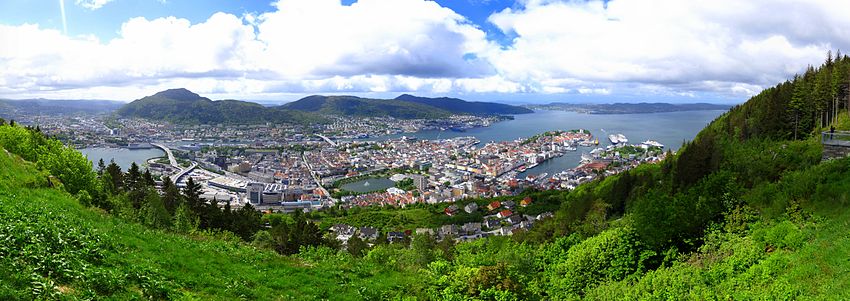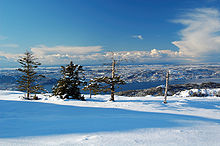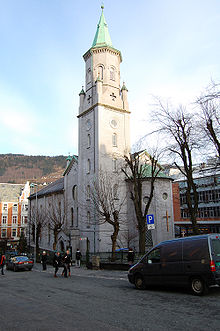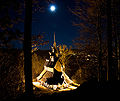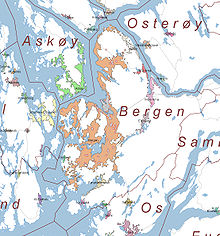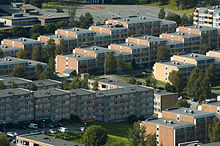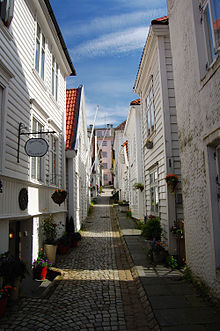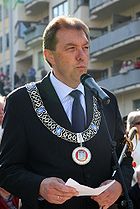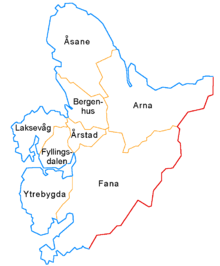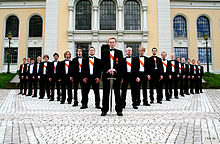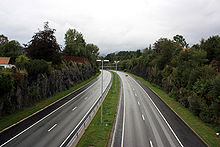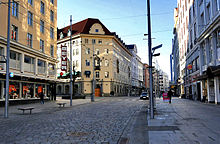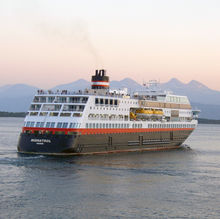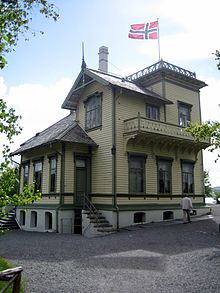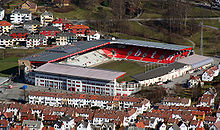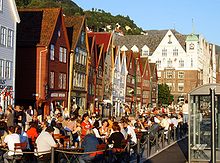- Bergen
-
Bergen — City — From top to bottom: city centre, buekorps, Gamlehaugen, Bryggen and Fyllingsdalen 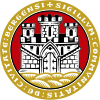
Coat of armsCoordinates: 60°23′22″N 5°19′48″E / 60.38944°N 5.33°ECoordinates: 60°23′22″N 5°19′48″E / 60.38944°N 5.33°E Country Norway Municipality Bergen County Hordaland District Western Norway Established 1070 Government – Mayor Trude Drevland (H) – Governing mayor Monica Mæland (H) Area – City 465 km2 (179.5 sq mi) – Urban 94.03 km2 (36.3 sq mi) – Metro 2,755 km2 (1,063.7 sq mi) Population (2011) – City 263,700 – Density 567.1/km2 (1,468.8/sq mi) – Urban 239,300 – Urban density 2,544.9/km2 (6,591.3/sq mi) – Metro 388,000 – Metro density 140.8/km2 (364.8/sq mi) Demonym Bergenser Ethnic groups[1] – Norwegians 87.6% – Poles 1.3% – Iraqis 0.6% – Vietnamese 0.4% – Chilean 0.4% Time zone CET (UTC+1) – Summer (DST) CEST (UTC+2) Twin Cities – Asmara Eritrea – Gothenburg Sweden – Newcastle upon Tyne United Kingdom – Seattle United States – Turku Finland – Aarhus Denmark Website http://www.bergen.kommune.no Bergen (Norwegian pronunciation: [ˈbærɡən] (
 listen)) is the second largest city in Norway with a population of 263,700 as of November 23, 2011.[2] Bergen is the administrative centre of Hordaland county. Greater Bergen or Bergen Metropolitan Area as defined by Statistics Norway, has a population of 388,000 as of November 23, 2011.[3]
listen)) is the second largest city in Norway with a population of 263,700 as of November 23, 2011.[2] Bergen is the administrative centre of Hordaland county. Greater Bergen or Bergen Metropolitan Area as defined by Statistics Norway, has a population of 388,000 as of November 23, 2011.[3]Bergen is located in the county of Hordaland on the south-western coast of Norway. It is an important cultural hub in its region, recognized as the unofficial capital of Western Norway and sometimes also referred to as the Atlantic coast capital of Norway.
Bergen's inter-municipal harbour, Port of Bergen, is by far Norway's largest and one of Europe's largest ports.[4]
The city was one of nine European cities honoured with the title of European Capital of Culture in the Millennium year.[5]
Contents
History
The city of Bergen, traditionally thought to have been founded by king Olav Kyrre, son of Harald Hardråde in 1070 AD,[6] four years after the Viking Age ended. Modern research has, however, discovered that a trading settlement was established already during the 1020s or 1030s.[7] It is considered to have replaced Trondheim as Norway's capital in 1217, and that Oslo became the de jure capital in 1299.[citation needed] Towards the end of the 13th century, Bergen became one of the Hanseatic League's most important bureau cities.[8]
The main reason for Bergen's importance was the trade with dried cod from the northern Norwegian coast,[9] which started around 1100. By the late 14th century, Bergen had established itself as the centre of the trade in Norway.[10] The Hanseatic merchants lived in their own separate quarter of town, where Middle Saxon was used, enjoying exclusive rights to trade with the northern fishermen that each summer sailed to Bergen.[11] Today, Bergen's old quayside, Bryggen is on UNESCO's list of World Heritage Site.[12]
The city has throughout its history been plagued with numerous great city fires. In 1198, the Bagler-faction set fire on the city in connection with a battle against the Birkebeiner faction during the civil war. In 1248, Holmen and Sverresborg burned, and 11 churches were destroyed. In 1413 another fire struck the city, and 14 churches were destroyed. In 1428 the city was plundered by pirates on a mission for the Hanseatic League, the same who was responsible for burning down Munkeliv Abbey in 1455. In 1476, Bryggen burned down in a fire started by a drunk trader. In 1582, another fire hit the city centre and Strandsiden. In 1675, 105 buildings burned down in Øvregaten. In 1686 a new great fire hit Strandsiden, destroying 231 city blocks and 218 boathouses. The greatest fire to date happened in 1702 when 90 percent of the city was burned to ashes. In 1751, there was a great fire at Vågsbunnen. In 1756, a new fire at Strandsiden burned down 1,500 buildings, and further great fires hit Strandsiden in 1771 and 1901. In 1916, 300 buildings burned down in the city centre, and in 1955 parts of Bryggen burned down.
In 1349, the Black Death was inadvertently brought to Norway by the crew of an English ship arriving in Bergen.[13] In the 15th century, the city was several times attacked by the Victual Brothers,[14] and in 1429 they succeeded in burning the royal castle and much of the city. In 1536, the King of the country was able to force the Saxon merchants to become Norwegian citizens, or else to return home, heralding a decline in the Saxon influence. In 1665, the city's harbour was the site of the Battle of Vågen, between English ships on the one side and Dutch ships supported by the city's garrison on the other.
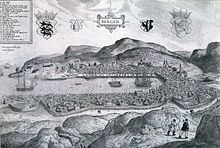 Hieronymus Scholeus's impression of Bergen. The drawing was made in about 1580 and was published in an atlas with drawings of many different cities (Civitaes orbis terrarum).[15]
Hieronymus Scholeus's impression of Bergen. The drawing was made in about 1580 and was published in an atlas with drawings of many different cities (Civitaes orbis terrarum).[15]
Throughout the 15th and 16th centuries, Bergen remained one of the largest cities in Scandinavia, and was Norway's biggest city until the 1830s,[16] when the capital city of Oslo became the largest. Bergen retained its monopoly of trade with Northern Norway until 1789.[17]
 A historic photochrom of Bergen near the end of the 19th century. Visible are Domkirken in the bottom left side and Korskirken in the foreground, Bryggen with its many boats and the Bergenhus Fortress in the background.
A historic photochrom of Bergen near the end of the 19th century. Visible are Domkirken in the bottom left side and Korskirken in the foreground, Bryggen with its many boats and the Bergenhus Fortress in the background.
During World War II, Bergen was occupied on the first day of the German invasion on 9 April 1940, after a brief fight between German ships and the Norwegian coastal artillery. On 20 April 1944, during the German occupation, the Dutch cargo ship Voorbode anchored off the Bergenhus Fortress, loaded with over 120 tons of explosives, blew up, killing at least 150 people and damaging historic buildings. The city was subject to some Allied bombing raids, aiming at German naval installations in the harbour. Some of these caused Norwegian civilian casualties numbering about 100.
Bergen was separated from Hordaland as a county of its own in 1831.[18] It was established as a municipality on 1 January 1838 (see formannskapsdistrikt). The rural municipality of Bergen landdistrikt was merged with Bergen on 1 January 1877.[19] The rural municipality of Årstad was merged with Bergen on 1 July 1915. The rural municipalities of Arna, Fana, Laksevåg, and Åsane were merged with Bergen on 1 January 1972. The city lost its status as a separate county on the same date.[20] Bergen is now a municipality in Norway, in the county of Hordaland.
In 1972, Bergen was unified with the neighbouring municipalities, of Arna, Fana, Laksevåg, and Åsane, abolishing its county status and setting its present boundaries.[20]
Toponymy
The Old Norse forms of the name were Bergvin and Bjǫrgvin (and in Icelandic and Faroese the city is still called Björgvin). The first element is berg (n.) or bjǫrg (n.), which translates to mountain(s). The last element is vin (f.), which means a new settlement where there used to be a pasture or meadow. The full meaning is then 'the meadow among the mountains'.[21] A suitable name: Bergen is often called 'the city among the seven mountains'. It was the playwright Ludvig Holberg who felt so inspired by the seven hills of Rome, that he decided that his home town must be blessed with a corresponding seven mountains - and locals still argue which seven they are.
In 1918, there was a campaign to reintroduce the Norse form Bjørgvin as the name of the city. This was turned down - but as a compromise the name of the diocese was changed to Bjørgvin bispedømme.[22]
Geography
 The city of Bergen is surrounded by mountains. Fløibanen, a funicular in Bergen which runs up the mountain of Fløyen. It is one of Bergen's major tourist attractions and one of Norway's most visited attractions. Over 1 million passengers a year have used it over the past few years. Fløibanen was officially opened on 15 January 1918.
The city of Bergen is surrounded by mountains. Fløibanen, a funicular in Bergen which runs up the mountain of Fløyen. It is one of Bergen's major tourist attractions and one of Norway's most visited attractions. Over 1 million passengers a year have used it over the past few years. Fløibanen was officially opened on 15 January 1918.
Bergen municipality occupies the majority of the Bergen peninsula in mid-western Hordaland. It is sheltered from the North Sea by the islands Askøy, Holsnøy (the municipality of Meland) and Sotra (the municipalities of Fjell and Sund).
The municipality covers an area of 465 km2. The population is 256,580[23] making the population density 551 people per km2. The population of the main urban area is 220,418.[24] The municipality also contains eight minor urban settlements with a total population of 17,213,[24] with Indre Arna, situated in the borough Arna, being the largest with a population of 6,151 as of 1 January 2007.[24]
Bergen's city centre is situated among a group of mountains known collectively as de syv fjell (the seven mountains), including the mountains Ulriken, Fløyen, Løvstakken and Damsgårdsfjellet, as well as three of the following: Lyderhorn, Sandviksfjellet, Blåmanen, Rundemanen, and Askøyfjellet. The first to name them "the seven mountains" might have been Ludvig Holberg,[25] inspired by the seven hills of Rome. These seven mountains are, however, only a few of the mountains located within the borders of the Bergen municipality. Gullfjellet is the highest mountain in Bergen, at 987 metres above sea level.[26]
Bergen borders the municipalities Meland, Lindås and Osterøy to the north, Vaksdal and Samnanger to the east, Os and Austevoll to the south, and Sund, Fjell and Askøy to the west.
Climate
Bergen features a temperate oceanic climate with relatively mild winters and cool summers. Despite being so far north, Bergen's weather is relatively mild. In the winter, Bergen is one of the warmest cities in Norway, caused by the Gulf Stream. The city is located further north than Saint Petersburg, yet winters are much warmer in Bergen than St. Petersburg.
Bergen experiences plentiful rainfall, with annual precipitation measuring 2,250 mm (89 in) on average.[28] This is because the city is surrounded by mountains that cause moist North Atlantic air to undergo orographic lift, which yields abundant rainfall. Rain fell every day between 29 October 2006 and 21 January 2007, 85 consecutive days.[29] In Bergen, precipitation is plentiful and heavy rain can happen at any time of the year. The highest temperature ever recorded was 31.8 °C, a record that dates back to 1947.[30] The lowest ever recorded is −16.3 °C, in 1987.[31]
The high precipitation is often used in the marketing of the city, and figures to a degree on postcards sold in the city. For some time there were umbrella vending machines in the city, but these did not turn out to be a success.[32]
Climate data for Bergen (1961-1990) Month Jan Feb Mar Apr May Jun Jul Aug Sep Oct Nov Dec Year Average high °C (°F) 3.6
(38.5)4.0
(39.2)5.9
(42.6)9.1
(48.4)14.0
(57.2)16.8
(62.2)17.6
(63.7)17.4
(63.3)14.2
(57.6)11.2
(52.2)6.9
(44.4)4.7
(40.5)10.5 Average low °C (°F) −0.4
(31.3)−0.5
(31.1)0.9
(33.6)3.0
(37.4)7.2
(45.0)10.2
(50.4)11.5
(52.7)11.6
(52.9)9.1
(48.4)6.6
(43.9)2.8
(37.0)0.6
(33.1)5.2 Precipitation mm (inches) 190
(7.48)152
(5.98)170
(6.69)114
(4.49)106
(4.17)132
(5.2)148
(5.83)190
(7.48)283
(11.14)271
(10.67)259
(10.2)235
(9.25)2,250
(88.58)Avg. precipitation days 21 17 19 17 17 16 18 19 23 24 22 22 235 Sunshine hours 18.6 56.5 93.0 147.0 186.0 189.0 167.4 142.6 87.0 58.9 24.0 9.3 1,179.3 Source: World Meteorological Organisation,[33] Hong Kong Observatory[34] Bergen Climate chart (explanation) J F M A M J J A S O N D 190401524−117061114931061471321710148181219017122831492711172597323551Average max. and min. temperatures in °C Precipitation totals in mm Source: WMO[33] Imperial conversion J F M A M J J A S O N D 7.53831639316.743344.548374.257455.262505.864537.563531158481152441044379.34033Average max. and min. temperatures in °F Precipitation totals in inches Climate change
In recent years, precipitation and winds have increased in the city. In late 2005, heavy rains caused floods and several landslides, the worst of which killed three people on 14 September. Some indications are that due to climate change, severe storms causing landslides and floods will become more powerful in the area and in surrounding counties in coming years. As a response, the municipality created a special 24-man rescue unit within the fire department in 2005, to respond to future slides and other natural disasters,[35] and neighbourhoods considered at risk of slides were surveyed in 2006.[36] As of October 2007, the prediction has been supported by over 480 landslides in Hordaland county from the spring of 2006 to the summer of 2007. Most of the slides hit roads however none of them caused damage to cars, buildings, or people,[37][38] until October 2007, when a large rock dislodged and killed the driver of a car.[39] Another concern is the risk of rising sea levels. Already today, Bryggen is regularly flooded at extreme tide, and it is feared that as sea levels rise, floods will become a major problem in Bergen. Floods may in the future reach the old fire station in Olav Kyrres Gate, as well as the railroad tracks leading out of the city.[40] It has therefore been suggested by among others Stiftelsen Bryggen, the foundation responsible for preserving the UNESCO site, that a sea wall, built so that it could be raised and lowered as demanded by the tides, be built outside the harbour to protect the city.[41]
Another effect of recent years' weather conditions in the area is that Norwegians increasingly believe that climate change is a threat.[42]
Demographics
Historical populations Year Pop. ±% 1769 18,827 — 1855 37,015 +96.6% 1900 94,485 +155.3% 1910 104,224 +10.3% 1920 118,490 +13.7% 1930 129,118 +9.0% 1940 — 1950 162,381 — 1960 185,822 +14.4% 1970 209,066 +12.5% 1980 207,674 −0.7% 1990 212,944 +2.5% 2000 229,496 +7.8% 2010 256,580 +11.8% Source: Statistics Norway.[43][44] Note: The municipalities of Arna, Fana, Laksevåg and Åsane were merged with Bergen 1 January 1972. Ethnic Norwegians make up 88.8% of Bergen's residents. Of these, 2.1% were first or second generation immigrants with Western backgrounds and 6.6% were first or second generation immigrants with non-Western backgrounds.[45] The population growth with 4,549 persons in 2009, which is a growth rate of 1,8%. 96% of the population live in urban areas. As of 2002, the average gross income for men above the age of 17 is 426,000 NOK, the average gross income for women above the age of 17 is 238,000 NOK, with the total average gross income being 330,000 NOK.[45] In 2007, there were 104.6 men for every 100 women in the age group of 20-39.[45] 22.8% of the population were under 17 years of age, while 4.5% were 80 and above.
Religion
Saint Paul Church, a Catholic Church in Bergen. The church is packed every Sunday, especially by Polish masses. Because of insufficient capacity, construction of 1-2 new Catholic churches is currently planned.
Registered in Bergen for 2010 are more than 7,300 Catholics (up from 408 in 1951),[46] 4,947 members of Protestant Free churches, 2,707 Muslims, 816 Hindus, 255 (up from 175 in 2009) Russian Orthodox and 147 (up from 98 in 2009) Oriental Orthodox.[47] The Church of Norway made up the majority of the population and there are also many other Protestant Free Churches. There is one Catholic Church and one Mosque. There is no Orthodox Church in Bergen, but one is planned because the Orthodox community is on of the fastest growing religious communities in Bergen. The Holy Epiphany Parish of Russian Orthodox Church has been active in the city since 2004.[48] Whereas more than 7.3% and 42,516 are Muslims in Oslo, the figures are just 1.0% and 2,533 in Bergen (actual numbers are likely higher). Bergen has a relatively low percentage of Muslims, in relation to many European cities, for example London and Malmö with 8.5% and 20.6% Muslims respectively.
Religion Members[49] Percent Church of Norway 201,006 79.74% Non-Religious 52,059 13.55% Saint Paul Catholic Church 7,300 2.84% Protestant Free churches 4,947 1.92% Islam 2,707 1.05% Hinduism 816 0.31% Russian Orthodox Christianity 255 0.09% Oriental Orthodox Christianity 147 0.05% Year 1876 1951 1976 2004 2008 Roman Catholics in Bergen 20 408 1,112 4,044 7,300 Percent 0.0% 0.3% 0.5% 1.7% 2.9% Year 2006 2010 Muslims in Bergen 1,892 2,707 Percent 0.7% 1.0% Churches
The churches of the Established Church (the Church of Norway) in Bergen are St Olav's Cathedral Church (Bergen Domkirken, or Cathedral), St Mary's Church (Mariakirken, currently closed for renovation), St John's Church (Johanneskirken), Holy Trinity Church (Nykirken, or New Church), Holy Cross Church (Korskirken), and St George's Church (Jurgenkirken, chapel of the leper hospital), together with the Nonneseter Abbey Chapel. There are also small churches of various other minority denominations, plus St Paul's Roman Catholic Church.
Immigration
Countries Population[50] Total 260,392 EU/EEA, USA, Canada, Australia and New Zealand 241,390 Asia, Africa, Latin America, Oceania except Australia and New Zealand, and Europe except the EU/EEA 19,002 The immigrant population (those with two foreign born parents) in Bergen, includes 23,682 individuals with backgrounds from 164 countries representing 9.56% of the city's population (2008). Of these, 40.8% have background from Europe, 36.0% from Asia, 12.4% from Africa, 7.8% from Latin America, 2.5% from North America and 0.5% from Oceania. The immigrant population in Bergen in the period 1993–2008 increased by 119.7%, while the ethnic Norwegian population has grown by 8.1% during the same period. The national average is 138.0% and 4.2%. The immigrant population has thus accounted for 43.6% of Bergen's population growth and 60.8% of Norway's population growth during the period 1993–2008, compared with 84.5% in Oslo.[51]
The immigrant population in Bergen has changed a lot since 1970. As of 1 January 1986, there were 2,870 persons with non-Western immigrant background in Bergen. In 2006, this figure had increased to 14,630, so the non-Western immigrant population in Bergen was five times higher than in 1986. This is a slightly slower growth than the national average, which has sextupled during the same period. Also in relation to the total population in Bergen, the proportion of non-Western increased significantly. In 1986, the proportion of the total population in the municipality of non-Western background was 3.6%. In January 2006, persons with non-Western immigrant background accounted for 6 percent of the population in Bergen. The share of Western immigrants has remained stable at around 2% in the period. The number of Poles in Bergen rose from 697 in 2006 to 3,128 in 2010.[52]
Country of origin Population (2001)[53] Percent of total population (2001) Total 230,948 100.0%  Norway
Norway216,153 93.5% Immigrants 14,795 6.4%  Vietnam
Vietnam1,154 0.4%  Chile
Chile1,154 0.4%  United Kingdom
United Kingdom855 0.3%  Sri Lanka
Sri Lanka834 0.3%  Iraq
Iraq805 0.3%  Bosnia-Herzegovina
Bosnia-Herzegovina636 0.2%  Denmark
Denmark631 0.2%  Sweden
Sweden630 0.2%  Germany
Germany563 0.2%  United States
United States525 0.2%  Iran
Iran432 0.1%  Yugoslavia
Yugoslavia367 0.1%  Turkey
Turkey345 0.1%  Pakistan
Pakistan336 0.1%  India
India333 0.1%  Poland
Poland275 0.1%  Philippines
Philippines242 0.1%  Somalia
Somalia220 0.0%  Netherlands
Netherlands219 0.0%  Iceland
Iceland210 0.0% Other countries 4,029 1.7% Country of origin Population (2011)[54] Percent of total population (2011) Total 260,392 100.0%  Norway
Norway228,354 87.6% Immigrants 32,038 12.3%  Poland
Poland3,563 1.3%  Iraq
Iraq1,758 0.6%  Vietnam
Vietnam1,287 0.4%  Chile
Chile1,244 0.4%  Germany
Germany1,237 0.4%  Sri Lanka
Sri Lanka1,152 0.4%  Sweden
Sweden1,111 0.4%  Somalia
Somalia1,090 0.4%  United Kingdom
United Kingdom1,014 0.3%  Bosnia and Herzegovina
Bosnia and Herzegovina831 0.3%  Lithuania
Lithuania830 0.3%  Thailand
Thailand770 0.2%  Denmark
Denmark716 0.2%  Iran
Iran703 0.2%  Philippines
Philippines650 0.2%  Turkey
Turkey643 0.2%  India
India628 0.2%  Russia
Russia626 0.2%  United States
United States547 0.2%  People's Republic of China
People's Republic of China535 0.2%  Bangladesh
Bangladesh200 0.1% Other countries 11,105 4.2% History of the Jews in Bergen
The first Jewish family settled in Bergen in 1857, but just about 150 of around 2,000 Jews in Norway settled in Bergen between 1851 and 1945. A congregation was established. Herschel Rabinowitz, the brother to Moritz Rabinowitz said in 1936 that "Bergen would never have a significant Jewish population". Eight years later, he was arrested and murdered in Auschwitz. The Jewish congregation in Bergen was removed after the Holocaust in Norway. In all, 20 Jews from Bergen were deported to Auschwitz and killed by the winter of 1942–1943. Ten of them lived in the Møhlenpris area, including the 29-year-old store employee Harry Hirsch Scheer. Each year the torch is lit at the Møhlenpris school on November 26th, the date on which the deportation with D/S Donau took place.[55][56][57]
Urban areas
According to Statistics Norway there are nine urban areas in the municipality. The largest, Bergen urban area, covers 94.03 km2 (36.31 sq mi) or just 20% of the municipality. The population density is 2,422 p/km2.
Population as of 1 January 2009:[58]
- Bergen urban area – 227,752
- Indre Arna – 6,296
- Fanahammeren – 3,613
- Ytre Arna – 2,522
- Hylkje – 2,195
- Espeland – 2,049
- Nordvik – 431
- Krokeidet – 337
- Flesland – 335
Cityscape
The city centre of Bergen is located west in the municipality, facing the fjord of Byfjorden. It is situated among a group of mountains known as the Seven Mountains, although the number is a matter of definition. From here, the urban area of Bergen extends to the north, west and south, and to its east is a large mountain massif. Outside of the city centre and the surrounding neighbourhoods (i.e. Årstad, inner Laksevåg and Sandviken), the majority of the population lives in relatively sparsely populated residential areas that have been built since the 1950s. While some are dominated by apartment buildings and modern terraced houses (e.g. Fyllingsdalen), others are dominated by single-family homes.[59]
The oldest part of Bergen is the area around the bay of Vågen in the city centre. Originally centred on the eastern side of the bay, Bergen eventually expanded west and southwards. Few buildings from the oldest period remain, the most significant being St Mary's Church from the 12th century. For several hundred years, the extent of the city remained almost constant. The population was stagnant, and the city limits were narrow.[60] In 1702, 7/8 of the city burned. Most of the old buildings of Bergen, including Bryggen (which was rebuilt in a medieval style), were built after the fire. The fire marked a transition from tar covered houses, as well as the remaining log houses, to painted and some brick-covered wooden buildings.[61]
The last half of the 19th century was a period of rapid expansion and modernisation of the city. The fire of 1855 west of Torgallmenningen led to the development of regularly sized city blocks in this area of the city centre. The city limits were expanded in 1876, and Nygård, Møhlenpris and Sandviken were urbanised with large-scale construction of city blocks housing both the poor and the wealthy.[62] Their architecture is influenced by a variety of styles; historicism, classicism and Art Nouveau.[63] The wealthy built villas between Møhlenpris and Nygård, and on the side of Fløyen, had also been added to Bergen in 1876. Simultaneously, an urbanisation process was taking place in Solheimsviken in Årstad, at the time outside of Bergen municipality, centred around the large industrial activity in the area.[64] The workers' homes in this area were poorly built, and little remains after large-scale redevelopment in the 1960s-1980s.
After Årstad became a part of Bergen in 1916, a development plan was applied to the new area. Few city blocks akin to those in Nygård and Møhlenpris were planned. Many of the worker class built their own homes, and many small, detached apartment buildings were built. After World War II, Bergen had again run short on land to build on, and, contrary to the original plans, many large apartment buildings were built in Landås in the 1950s and 1960s. Bergen acquired Fyllingsdalen from Fana municipality in 1955. Like similar areas in Oslo (e.g. Lambertseter), Fyllingsdalen was developed into a modern suburb with large apartment buildings, mid-rises, and some single-family homes, in the 1960s and 1970s. Similar developments took place outside of Bergen's city limits, for example in Loddefjord.[65]
At the same time as planned city expansion took place inside Bergen, its extra-municipal suburbs too grew rapidly. Wealthy citizens of Bergen had been living in Fana since the 19th century, but as the city expanded it became more convenient to settle in the municipality. Similar processes took place in Åsane and Laksevåg. Most of the homes in these areas are detached row houses, single family homes or small apartment buildings.[65] Since the surrounding municipalities were merged with Bergen in 1972, expansion has continued in largely the same manner, although the municipality encourages condensing near commercial centres, future Bergen Light Rail stations, and elsewhere.[66][67]
As part of the modernisation wave of the 1950s and 1960s, and due to damages caused by World War II, the city government ambitiously developed redevelopment plans for many areas in central Bergen. The plans involved demolition of several neighbourhoods of wooden houses, namely Nordnes, Marken, and Stølen. None of the plans were carried out in their original form, the Marken and Stølen redevelopment plans discarded entirely and that of Nordnes only carried out in the area that had been most damaged by war. The city council of Bergen had in 1964 voted to demolish the enterity of Marken, however, the decision proved to be strongly controversial and the decision was reversed in 1974. Bryggen was under threat of being wholly or partly demolished after the fire of 1955, when a large number of the buildings burned to the ground. Instead of being demolished, the remaining buildings were eventually restored and accompanied by reconstructions of some of the burned buildings.[65] Demolition of old buildings and occasionally whole city blocks is still taking place, the most recent major example being the razing of Jonsvollskvartalet at Nøstet.[68]
Neighbourhoods of Bergen, Norway Bergenhus Administration
Mayor of The City of Bergen 
Seal of the City of BergenAppointer Herman Friele Term length 2 years Formation 17th century Succession Currently unknown Since 2000, the city of Bergen is governed by a city government (byråd) based on the principle of parliamentarism.[69] The government consists of 6 government members called commissioners, and is appointed by the city council, the supreme authority of the city. Since the local elections of 2007, the city has been ruled by a right-wing coalition of the Progress Party, the Christian Democratic Party and the Conservative Party, each with two commissioners.[70] The Progress Party member Gunnar Bakke is mayor,[71] while conservative Monica Mæland is the leader of the city government,[72] the most powerful political position in Bergen.
2007 elections
Bergen city council 2007–2011[73] Conservative Party 18 (0) Labour Party 16 (+1) Progress Party 14 (+2) Socialist Left Party 5 (–3) Christian Democratic Party 4 (0) Liberal Party 4 (+2) Red Electoral Alliance 3 (–1) Centre Party 2 (+1) Pensioners' Party 1 (–2) Total 67 The 2007 city council elections were held on 10 September. The Socialist Left Party (SV) and the Pensioners Party (PP) ended up as the losers of the election, SV going from 11.6% of the votes in the 2003 elections to 7.1%, and PP losing 2.9% ending up at 1.2%. The Liberal Party more than doubled, going from 2.7% to 5.8%. The Conservative Party lost 1.1% of the votes, ending up at 26.3%, while the Progress Party got 20.2% of the votes, a gain of 3% since the 2003 elections. The Christian Democratic Party gained 0.2%, ending up at 6.3%. The Red Electoral Alliance lost 1.4%, ending up at 4.5%, while the Centre Party gained 1.2%, ending up at 2.8%. Finally, the Labour Party continued being the second largest party in the city, gaining 1% and ending up at 23.9%.[74]
Boroughs
Bergen is divided into 8 boroughs,[75] as seen on the map to the left. Going clockwise, starting north, the boroughs are Åsane, Arna, Fana, Ytrebygda, Fyllingsdalen, Laksevåg, Årstad and Bergenhus. The city centre is located in Bergenhus. Parts of Fana (= the fens), Ytrebygda, Åsane (= the hills) and Arna are not part of the Bergen urban area, explaining why the municipality has approximately 20,000 more inhabitants than the urban area. The separate borough administrations were closed 30 June 2004,[76] but were re-established 1 January 2008.[77]
Borough Population[78] % Area (km2) % Density
(/km2)Arna 12,680 4.9 102.44 22.0 123 Bergenhus1 38,544 14.8 26.58 5.7 4.415 Fana 38,317 14.8 159.70 34.3 239 Fyllingsdalen 28,844 11.1 18.84 4.0 1.530 Laksevåg 38,391 14.8 32.72 7.0 1.173 Ytrebygda 25,710 9.9 39.61 8.5 649 Årstad2 37,614 14.5 14.78 3.2 4.440 Åsane 39,534 15.2 71.01 15.2 556 Not stated 758 Total 260,392 100 465.68 100 559 The following acreage figures in the table include fresh water and uninhabited mountain areas.
1 1 The borough Bergenhus is 8.73 km (5.42 mi) ², the rest is water and uninhabited mountain areas.
2 2 The borough Årstad is 8.47 km (5.26 mi) ², the rest is water and uninhabited mountain areas.Education
Higher education
Bergen has one university, the University of Bergen, and one university college, Bergen University College, with a total of 22,000 students and 3,600 staff. With approximately 16,000 students and 3,000 staff,[79] the University of Bergen (Norwegian: Universitetet i Bergen) is the third largest university in Norway, after the University of Oslo and the Norwegian University of Science and Technology. Although it was founded as late as 1946, academic activity had been taking place at Bergen Museum since 1825. The university's academic profile focuses on marine research and co-operation with developing countries.[80] In 2002, the university was awarded three national centres of excellence in climate research, petroleum research and medieval studies.[81] In December 2004, billionaire Trond Mohn donated 250 million NOK to the University as research funding.[82] In addition, he has given the university several individual gifts of 50 million NOK.[83][84]
Bergen University College (Norwegian: Høgskolen i Bergen) is one of 24 state-owned university colleges in Norway. As of 2007, it has approximately 6,000 students and 600 staff.[85] The university college offers studies directed towards specific professions. The college is organised in 3 faculties: the Faculty of Education, the Faculty of Engineering, and the Faculty of Health and Social Sciences.
The Norwegian School of Economics and Business Administration (Norwegian: Norges Handelshøyskole) is a leading school of business and economics in Norway. Finn E. Kydland, the most recent (2004) of three Norwegian laureates of the Economy Nobel Prize,[86] has studied and lectured at the school. The school has approximately 2,700 students and 350 staff.[87] As the result of a resolution passed by the Norwegian Storting in 1917, the school was founded in 1936 as the first business school in Norway. As of 2007, the school's MSc programme is ranked by the Financial Times as the 36th best in Europe.[88]
The Bergen School of Architecture (Bergen Arkitekt Skole), founded in 1986 by architect Svein Hatløy, has alternative programs, with graduates like 3RW arkitekter and Tommie Wilhemsen.
The Bergen National Academy of the Arts (Kunsthøgskolen i Bergen, approximately 300 students and 100 staff)[89] is one of the two independent institutions of higher learning in the visual arts and design in Norway. Students can take a three-year Bachelor degree and a two-year Master degree in the following areas: Visual Art, Interior Architecture, Furniture Design, Room Design, Visual Communications, Photography, Printmaking, Ceramics and Textiles.
The Naval Academy (Sjøkrigsskolen) of the Royal Norwegian Navy is located at Laksevåg in Bergen.
Primary and secondary education
There are 64 elementary schools,[90] 18 lower secondary schools[91] and 20 upper secondary schools[92] in Bergen, as well as 11 combined elementary/lower secondary schools.[93]
Bergen Katedralskole (Latin: Scholae Bergensis Cathedralis) is believed to have been founded in 1153 by Pope Adrian IV[94] (then known as Nicholas Breakspear), thus making it Bergen's oldest school and one of the oldest schools in Norway. The school moved to its present location in 1840, and the old building was left mostly unused until the School Museum of Bergen moved into the building in 2003.[95] Since 1972, the school is a regular upper secondary school (similar to a high school in the United States and the United Kingdom).
In 2006, Bergen Handelsgymnasium, an upper secondary school in Bergen, was chosen as a finalist in the The Holberg Prize School Project.[96]
Research
The University of Bergen and Haukeland University Hospital are by far the largest research institutions in Bergen.
The Chr. Michelsen Institute (Christian Michelsens Institutt), founded in 1930, is located in Bergen. With an annual turnover of 56 million NOK,[97] it is one of Scandinavia's largest independent research institutes on human rights and development issues. The aim of CMI is to inform and influence policy on international development issues.[97]
The Norwegian Institute of Marine Research (Norwegian: Havforskningsinstituttet), formerly known as Norwegian Fisheries Investigations (Norwegian: Norske Fiskeriundersøgelser) has been located in Bergen since 1900. The primary responsibility of the institute is to provide advice to national authorities, society and industry regarding questions related to the ecosystems of the Barents Sea, the Norwegian Sea, the North Sea and the Norwegian coastal zone and in the field of aquaculture. The institute has a staff of 700,[98] making it the largest marine research institution in Norway.
UNIFOB AS is a non-profit research organisation affiliated with the University of Bergen. Unifob conducts research and associated activities across all the scientific fields covered by the university departments, including Petroleum, Health, Computational Science, Marine Molecular Biology.
Economy
Bergen's inter-municipal harbour is by far Norway's largest port and one of Europe's largest ports, according to the inter-municipal company Port of Bergen.[4]
In August 2004, Time magazine named the city one of Europe's 14 "secret capitals"[99] where Bergen's capital reign is acknowledged within maritime businesses and activities such as aquaculture and marine research, with the Institute of Marine Research (IMR) (the second-largest in Europe) as the leading institution. Bergen is the main base for the Royal Norwegian Navy (at Haakonsvern) and its international airport Flesland is the main heliport for the huge Norwegian North Sea oil and gas industry, from where thousands of offshore workers commute to their work places onboard oil and gas rigs and platforms.[100]
The headquarters of TV 2 Norway's largest commercial television channel are located in Bergen.
One of Norway's largest shopping malls, Lagunen Storsenter, is located in Fana in Bergen, with a turnover of 2 540 million Norwegian kroner, and 5.2 million visitors every year.
Tourism is an important income source for the city. The hotels in the city may be full at times,[101][102] due to the increasing number of tourists and conferences. Prior to the Rolling Stones concert in September 2006, many hotels were already fully booked several months in advance.[103] Bergen is recognised as the unofficial capital of the region known as Western Norway, and recognised and marketed as the gateway city to the world famous fjords of Norway and for that reason it has become Norway's largest - and one of Europe's largest - cruise ship ports of call.[104]
Transportation
Bergen has an international airport, Bergen Airport, Flesland, with direct flights to several European cities. The Bergensbanen railway line runs east to Voss, Geilo, Hønefoss and Oslo.
The E39 road passes through the city, connecting to Trondheim and Stavanger. The E16 road to Oslo passes through the Lærdalstunnelen, the longest road tunnel in the world.[105] Bergen was the first city in Northern Europe to introduce a ring of toll roads entirely surrounding the city, making entering the city centre by car impossible without paying the toll. The toll road system, established to fund new roads and motorways, opened 2 January 1986.
The toll was collected by both toll plazas and an electronic toll collection system. In the early 2000s, the electronic toll collection system AutoPASS was introduced, replacing both the remaining toll plazas and the existing but dated electronic toll collection system.[106]
Public transportation is provided by the transportation company Tide, the result of a merger between Gaia and HSD. Among the fleet of buses are 8 trolleybuses (two of which are dual-mode buses). Local train transport to Arna is provided by Norges Statsbaner. There is a funicular (Fløibanen) and an aerial tramway (Ulriksbanen). The city's tram system was closed in 1965, although a museum line still operates on Møhlenpris.[107] The first stage of a modern light rail system was opened 22 June 2010, and connects the city centre with Nesttun.[108] Express buses go to all larger destinations in Norway.[109][110][111]
The Norwegian coastal steamer service Hurtigruten originates in Bergen, running north to Trondheim, Bodø, Tromsø and Kirkenes.[112] Passenger catamarans run from Bergen south to Haugesund and Stavanger,[113] and north to Sognefjorden and Nordfjord.[114] Car ferries connect to Hanstholm[115] and Hirtshals[116] in Denmark. The ferries to Lerwick,[117] Scrabster,[117] Tórshavn[117] on the Faroe Islands, and Seyðisfjörður[117] in Iceland are not operative anymore. The service from Newcastle[118] in the United Kingdom, once provided by such ships as the Leda, was cancelled after 1 September 2008.[119]
Culture and sports
Bergen is an important cultural centre in its region and in Norway, maybe best known for hosting the annual Bergen International Festival (Festspillene i Bergen). The city is home to the Bergen Philharmonic Orchestra, which was founded in 1765 and is one of the world's oldest orchestral institutions.[120] The orchestra performs regularly at the 1,500 seat[121] Grieg Hall. The city is also home of the Bergen Woodwind Quintet, which is made up primarily of principal winds of the Bergen Philharmonic. Bergen was a European Capital of Culture in 2000.[122] Other main cultural events include Borealis,[123] Nattjazz, Lost Weekend Festivalen and Bergenfest (formerly Ole Blues).[124]
There are numerous amateur bands in Bergen and the surrounding communities performing regularly throughout the city. They generally fall within two distinct categories: brass bands, following the British band tradition, and Janitsjar or wind bands, which include both woodwind and brass instruments. Both of these types of bands tend to be quite competitive, and the Grieg Hall in Bergen is home to the annual Norwegian Brass Band Championships, which takes place in late winter.[125]
A third category, perhaps unique to Bergen, are the Buekorps, a prominent feature in the Constitution Day celebrations in the city. Buekorps parade in the streets with wooden sticks shaped as guns or crossbows, sabres and even halberds, to a military snare sounded by several drummers. The performers are usually boys between 7 and 21 years of age, but older veterans can be seen. In recent times there are buekorps for girls and for both girls and boys as well. Buekorps are regarded with warmth by some, whilst others dislike them due to their militarised appearance or the dominant sound of the drumming.[126][127]
In the late 1990s and early 2000s several pop, rock and black metal artists from Bergen became famous, at home as well as abroad. Many of these were connected to the small record label Tellé Records.[128] In the domestic press this became known as the Bergen Wave.[129][130]
Bergen has a small but thriving scene for contemporary art, most notably centred around BIT Teatergarasjen, Bergen Kunsthall, United Sardines Factory (USF) and Bergen Center for Electronic Arts (BEK).
With circulations of 87,076 and 30,719 in 2006,[131] Bergens Tidende and Bergensavisen are the two largest newspapers in Bergen. Bergens Tidende has won three European Newspaper Awards, in 2006 for best designed regional newspaper,[132] in 2004 for best designed weekly newspaper,[133] and in 2002 for best designed regional newspaper.[134] The city is also the home of several smaller newspapers and publications, including Fanaposten (circulation of 4,062[131]), a local newspaper for Fana, Bygdanytt in Arna, and the Christian newspaper Dagen (circulation of 8,936[131]).
Football
Bergen has two professional football teams, Brann and Løv-Ham. Brann plays in Tippeligaen,[135] Norway's top football division, while Løv-Ham plays in the first division.[136] Despite Løv-Ham playing in the 2nd highest level in Norwegian football, Brann is the only club to draw any considerable interest from the public. The first Løv-Ham supporter group, Selskapsløvene (English: The Party Lions) was created as recently as December 2005.[137] Brann play their matches at Brann Stadion, with a capacity of 17,824[138] as of June 2007, while Løv-Ham played their matches at Krohnsminde kunstgressbane until 2008, with a capacity of 3000, but an attendance record of 1051 in the league.[139] They now play their games at Varden Amfi in Fyllingsdalen.
Although Brann is one of the largest teams in Norway, the team has had limited success in the Premier League and the cup. They have won the cup six times, most recently in 2004. Brann won the Premier League in 1961/62 and then in 1963. The 1963 title was directly followed by the relegation of the team into the Second Division (today known as Adeccoligaen, the second highest level of Norwegian football). The team has won several silver and bronze medals since, but did not win the league again until the 2007 season.[140]
Dialect
Bergensk, or the Bergen dialect, is the dialect of Norwegian spoken in Bergen. It is easy for Norwegians to recognise, as it is very easily distinguished from the other dialects in Hordaland. Like almost all Norwegian dialects, Bergensk cannot be said to be either Bokmål or Nynorsk. While the vocabulary shows many traits of both Bokmål and Nynorsk, it has many characteristics that are not covered by either of the two official written languages.
Foreigners, such as the Low German speaking merchants of the Hanseatic League who lived in Bergen in the period from about 1350 to 1750, have had a profound impact on the dialect.[141] Bergen being the major Norwegian city during the Dano-Norwegian union from 1536 to 1814 led to Bergensk absorbing more of the Danish than other Norwegian dialects. Many, but not all, influences from these languages since spread from Bergen to parts of or the whole of Norway.[141]
The female grammatical gender disappeared from Bergensk in the 16th century, probably as a result of influences from Danish,[141] making the city's dialect one of the very few in Norway with only two grammatical genders. All others, excepting sociolects in other Norwegian cities, have three. The Rs are uvular trills, as in French, which probably spread to Bergen (and Kristiansand) some time in the 18th century, overtaking the alveolar trill in the time span of 2 to 3 generations.[141] Owing to an improved literacy rate, Bergensk was influenced by riksmål and bokmål in the 19th and 20th centuries. This led to large parts of the German-inspired vocabulary disappearing and pronunciations shifting slightly towards East Norwegian.[141]
Notable residents
Main article: Famous people from BergenMain category: People from BergenInternational relations
Each year Bergen donates the Christmas Tree seen in Newcastle's Haymarket as a sign of the ongoing friendship between the sister cities.[142] The Nordic friendship cities of Bergen, Gothenburg, Turku and Aarhus arranges inter Nordic camp schools each year by inviting school classes, 10 grade level from each of the other cities on school camps. Bergen received a totem pole as a gift of friendship from the city of Seattle on the city's 900 anniversary in 1970. It is now placed in the Nordnes park and gazes out over the sea towards the friendship city far to the west.
Sister Cities
See also: List of twin towns and sister cities in Norway Asmara, Eritrea [143]
Asmara, Eritrea [143] Gothenburg, Sweden [143]
Gothenburg, Sweden [143] Lübeck, Germany (since 1996 - Friendship Treaty) [144]
Lübeck, Germany (since 1996 - Friendship Treaty) [144] Málaga, Spain
Málaga, Spain Newcastle, United Kingdom (since 1968)[143][145]
Newcastle, United Kingdom (since 1968)[143][145] Quebec City, Canada
Quebec City, Canada Rostock, Germany (since 1965)
Rostock, Germany (since 1965) Seattle, United States(since 1967)[143][146]
Seattle, United States(since 1967)[143][146] Turku, Finland (since 1946) [143]
Turku, Finland (since 1946) [143] Aarhus, Denmark[143][147]
Aarhus, Denmark[143][147]
References
Notes
- ^ "Immigrants and Norwegian-born to immigrant parents by country of birth1,(the 20 largest groups).Selected municipalities.1 January 2011". Statistics Norway. http://www.ssb.no/innvbef_en/tab-2011-04-28-10-en.html. Retrieved 2011-04-28.
- ^ "Population per 1 April 2011 and population changes during 1st quarter of 2011. Hordaland". Ssb.no. 2011-04-01. http://www.ssb.no/english/subjects/02/02/folkendrkv_en/2011k1/kvart12-en.html. Retrieved 2011-06-08.
- ^ "Bergen Region". Ssb.no. http://en.wikipedia.org/wiki/Bergen_Region.
- ^ a b "Bergen havn holder koken" (in Norwegian). NA24. 2004. http://www.bt.no/na24/article278586.ece. Retrieved 16 August 2007.
- ^ "European Capitals of Culture 2000 - 2005". European Commission. 4 May 2006. Archived from the original on 2007-01-17. http://web.archive.org/web/20070117202517/http://ec.europa.eu/culture/eac/other_actions/cap_europ/cap_00_01_02_en.html. Retrieved 26 April 2007.
- ^ Elisabeth Farstad (2007). "Om kommunen" (in Norwegian). Bergen kommune. http://www.bergen.kommune.no/aktuelt/omkommunen. Retrieved 16 September 2007.
- ^ NRK, "Bergens historie må skrives om"
- ^ Kloster, Robert (1952). Castle and City: Through historical Bergen.
- ^ Marguerite Ragnow (2007). "Cod". http://bell.lib.umn.edu/Products/cod.html. Retrieved 14 August 2007.
- ^ Alf Ragnar Nielssen (1 January 1950). "Indigenous and Early Fisheries in North-Norway" (PDF). The Sea in European History. http://www.stm.unipi.it/Clioh/tabs/libri/1/12-Nielssen(6).pdf. Retrieved 2009-07-22.
- ^ Anette Skogseth Clausen. "7. oktober 1754 - fra et hanseatisk kontor til et norsk kontor med hanseater" (in Norwegian). Arkivverket. http://www.riksarkivet.no/bergen/publikasjoner/artiklar/andre/kontoret.html. Retrieved 9 October 2007.
- ^ UNESCO (2007). "World Heritage List". http://whc.unesco.org/en/list/59. Retrieved 14 August 2007.
- ^ Carl Hecker, Justus Friedrich (1833). The Black Death in the Fourteenth Century. http://books.google.com/?id=WYpLLDoMTxQC&pg=PA18.
- ^ Downing Kendrick, Thomas (2004). A History of the Vikings. p. 142. ISBN 9780486433967. http://books.google.com/?id=3Z8NgXgRytUC&pg=PA142&dq=victual+brothers+bergen.
- ^ Brekke, Nils Georg (1993) (in Norwegian). Kulturhistorisk vegbok Hordaland. Bergen: Hordaland Fylkeskommune. ISBN 82-7326-026-7.
- ^ "Innvandring 1600-2000, Arkivenes dag 2002" (in Norwegian). Arkivverket. http://www.arkivverket.no/webfelles/sab/innvandring/index.html. Retrieved 9 October 2007.
- ^ Ivan Kristoffersen (2003). "Historien om Norge i nord" (in Norwegian). Norwegian Ministry of Foreign Affairs. http://www.regjeringen.no/nb/dep/ud/dok/NOU-er/2003/NOU-2003-32/10.html?id=373172. Retrieved 9 October 2007.
- ^ "Distriktsinndeling og navn" (in Norwegian). Fornyings- og administrasjonsdepartementet. http://www.regjeringen.no/nb/dep/fad/dok/Veiledninger_og_brosjyrer/1995/Fylkesmannboka/4-Fylkesmannsembetene/43-Distriktsinndeling-og-navn.html?id=464957. Retrieved 16 September 2007.
- ^ Statistics Norway (1999). "Historisk oversikt over endringer i kommune- og fylkesinndelingen" (in Norwegian) (PDF). http://www.ssb.no/emner/00/90/rapp_9913/rapp_9913.pdf. Retrieved 14 August 2007.
- ^ a b Bergen Kommune (2007). "Styringssystemet i Bergen kommune" (in Norwegian) (PDF). Archived from the original on 2008-02-27. http://web.archive.org/web/20080227085411/http://byfjellene.no/bystyre_/ekstern/Styringssystemet_korrektur_fra_kommuneforlaget.pdf. Retrieved 14 August 2007.
- ^ Brekke, Nils Georg (1993) (in Norwegian). Kulturhistorisk vegbok Hordaland. Bergen: Hordaland Fylkeskommune. p. 252. ISBN 82-7326-026-7.
- ^ "Bjørgvin bispedøme" (in Norwegian). Scandion.no. 2004. Archived from the original on 2007-12-26. http://web.archive.org/web/20071226020759/http://www.scandion.no/article/archive/826/. Retrieved 10 October 2007.
- ^ "Population, by sex, age and municipality. Hordaland. 1 January 2010". Statistics Norway. 2010. Archived from the original on 2010-03-15. http://web.archive.org/web/20071212035316/http://www.ssb.no/english/subjects/02/01/10/folkemengde_en/tab-2010-03-11-14-en.html. Retrieved 15 March 2010.
- ^ a b c "Urban settlements. Population and area, by municipality. 1 January 2007". Statistics Norway. 2007. Archived from the original on 2008-01-06. http://web.archive.org/web/20080106220228/http://www.ssb.no/english/subjects/02/01/10/beftett_en/tab-2007-06-07-01-en.html. Retrieved 15 October 2007.
- ^ Gunhild Agdesteen (2007). "I den syvende himmel" (in Norwegian). Bergens Tidende. http://www.bt.no/kuriosa/article380762.ece. Retrieved 14 August 2007.
- ^ "Norwegian Mountains: Gullfjellstoppen". http://www.westcoastpeaks.com/Peaks/gullfjellstoppen.html. Retrieved 8 September 2007.
- ^ Bergens Tidende - 91 dager med snø
- ^ Meterologisk Institutt (2007). "met.no: Normaler for Bergen" (in Norwegian). http://met.no/observasjoner/hordaland/normaler_for_kommune_1201.html. Retrieved 16 August 2007.
- ^ ANB-NTB (2007). "Stopp for nedbørsrekord" (in Norwegian). siste.no. http://www.siste.no/Innenriks/var_og_uvar/article2537456.ece. Retrieved 9 October 2007.
- ^ "Varmerekord i Bergen" (in Norwegian). 2003. http://www.dagbladet.no/nyheter/2003/07/16/373782.html. Retrieved 16 August 2007.
- ^ Bjørbæk, G. 2003. Norsk vær i 110 år. N.W. DAMM & Sønn. ISBN 82-04-08695-4; page 260
- ^ "Paraply-fiasko i Bergen" (in Norwegian). Archived from the original on 2007-12-15. http://web.archive.org/web/20071215094128/http://www.hegnar.no/hegnar/newsdet.asp?id=171839. Retrieved 16 August 2007.
- ^ a b "World Weather Information Service - Bergen". World Meteorological Organization. http://worldweather.wmo.int/008/c00022.htm. Retrieved 2010-05-20.
- ^ "Climatological Normals of Bergen". Hong Kong Observatory. http://www.hko.gov.hk/wxinfo/climat/world/eng/europe/n_europe/bergen_e.htm. Retrieved 2010-05-20.
- ^ Jan I. Eliassen (14 November 2006). "Bergen oppretter egen rasgruppe" (in Norwegian). Bergens Tidende. http://www.bt.no/lokalt/bergen/article314825.ece. Retrieved 11 September 2007.
- ^ Kari Pedersen (28 September 2005). "Rasfare sjekkes i hele kommunen" (in Norwegian). Bergen Tidende. Archived from the original on February 16, 2006. http://web.archive.org/web/20060216031919/http://www.bt.no/lokalt/article210511.ece. Retrieved 11 September 2007.
- ^ Tor Sandberg (2 February 2006). "I værgudenes vold" (in Norwegian). Dagsavisen. http://www.dagsavisen.no/innenriks/article266233.ece. Retrieved 11 September 2007.
- ^ Johan Lindebotten (4 September 2007). "480 ras på vegene i Hordaland" (in Norwegian). Bergens Tidende. http://www.bt.no/valg07/article404482.ece. Retrieved 12 October 2007.
- ^ Jostein Ihlbæk (16 October 2007). "Kvinne omkom da stein gikk gjennom frontruten" (in Norwegian). Aftenposten. http://www.aftenposten.no/nyheter/iriks/article2050231.ece. Retrieved 15 November 2007.
- ^ Cato Guhnfeldt (22 April 2007). "Bergen går våt fremtid i møte" (in Norwegian). Aftenposten. http://www.aftenposten.no/nyheter/iriks/article1750317.ece. Retrieved 11 September 2007.
- ^ Øivind Ask (6 December 2006). "Sluse kan redde Bryggen" (in Norwegian). Bergens Tidende. http://www.bt.no/lokalt/bergen/tettpa/article321091.ece. Retrieved 11 September 2007.
- ^ Eva Røyrane, Hans K. Mjelva (2 January 2007). "Klimaskepsisen fordampa i rekordvarmt år" (in Norwegian). Bergens Tidende. http://www.bt.no/miljo/article328201.ece. Retrieved 11 September 2007.
- ^ "Microsoft Word - FOB-Hefte.doc" (in (Norwegian)) (PDF). http://www.ssb.no/fob/kommunehefte/1201/fob_1201_tabeller.pdf. Retrieved 2009-07-07.
- ^ "Tabell 6 Folkemengde per 1. januar, etter fylke og kommune. Registrert 2009. Framskrevet 2010-2030, alternativ MMMM" (in (Norwegian)). Ssb.no. http://www.ssb.no/emner/02/03/folkfram/arkiv/tab-2009-06-11-06.html. Retrieved 2009-07-07.
- ^ a b c "SSB: Tall om Bergen kommune" (in Norwegian). Statistics Norway. http://www.ssb.no/kommuner/hoyre_side.cgi?region=1201. Retrieved 1 October 2007.
- ^ Bergens Tidende - Norwegian
- ^ Fylkesmannen i Hordaland - Norwegian
- ^ Den Kristi Apenbaringsmenighet i Bergen Den russiske ortodokse kirke Moskvapatriarkatet
- ^ County Mayor of Hordaland - Norwegian
- ^ "Immigrants and Norwegian-born to immigrant parents, by country background and municipality. 1 January 2011. Absolute figures and per cent". Statistics Norway. http://www.ssb.no/innvbef_en/tab-2011-04-28-09-en.html. Retrieved 2011-04-28.
- ^ Statistics Norway - Stat Bank
- ^ Immigrant population in Bergen
- ^ Statistics Norway - Immigrant population by counntry of birth, (largest groups) Selected municipalities. 1 January 2001
- ^ Statistics Norway - Immigrants and Norwegian-born to immigrant parents, by country of birth, (the 20 largest groups). Selected municipalities. 1 January 2011
- ^ Mulighetenes land - Norwegian
- ^ på Høyden - Norwegian
- ^ Bergens Tidende - Norwegian
- ^ Statistics Norway (2009). Urban settlements. Population and area, by municipality. 1 January 2009. http://www.ssb.no/english/subjects/02/01/10/beftett_en/tab-2009-06-20-01-en.html.[dead link]
- ^ Hagen Hartvedt, Gunnar (1994). "Bergen". Bergen Byleksikon (1st ed.). Oslo: Kunnskapsforlaget. pp. 27. ISBN 82-573-0485-9.
- ^ Hagen Hartvedt, Gunnar (1994). "Bergen". Bergen Byleksikon (1st ed.). Oslo: Kunnskapsforlaget. pp. 23. ISBN 82-573-0485-9.
- ^ Hagen Hartvedt, Gunnar (1994). "Bergen". Bergen Byleksikon (1st ed.). Oslo: Kunnskapsforlaget. pp. 25. ISBN 82-573-0485-9.
- ^ Østerbø, Kjell (23 September 2007). "Da rike og fattige fikk sine strøk" (in Norwegian). Bergens Tidende. http://www.bt.no/lokalt/bergen/article413890.ece. Retrieved 18 December 2008.
- ^ Hagen Hartvedt, Gunnar (1994). "Bergen". Bergen Byleksikon (1st ed.). Oslo: Kunnskapsforlaget. pp. 25–26. ISBN 82-573-0485-9.
- ^ Hagen Hartvedt, Gunnar (1994). "Bergen". Bergen Byleksikon (1st ed.). Oslo: Kunnskapsforlaget. pp. 26–27. ISBN 82-573-0485-9.
- ^ a b c Hagen Hartvedt, Gunnar (1994). "Bergen". Bergen Byleksikon (1st ed.). Oslo: Kunnskapsforlaget. pp. 9–61. ISBN 82-573-0485-9.
- ^ Mæland, Pål Andreas (16 May 2008). "Nå kommer slangen til Paradis" (in Norwegian). Bergens Tidende. http://www.bt.no/lokalt/bergen/article564560.ece. Retrieved 18 December 2008.
- ^ Røyrane, Eva (9 May 2007). "Bergen bygges tettere" (in Norwegian). Bergens Tidende. http://bt.no/forbruker/husoghjem/article361530.ece. Retrieved 18 December 2008.
- ^ Okkenhaug, Liv Solli (21 April 2007). "Rev de siste husene" (in Norwegian). Bergens Tidende. http://www.bt.no/lokalt/bergen/article357421.ece. Retrieved 18 December 2008.
- ^ "Styringssystem" (in Norwegian). Bergen kommune. Archived from the original on 2007-10-15. http://web.archive.org/web/20071015152459/http://bergen.kommune.no/bystyre_/ekstern/styringssystem.html. Retrieved 9 October 2007.
- ^ Christian Lura (2007). "- Fantastisk å bli spurt" (in Norwegian). Bergens Tidende. http://www.bt.no/lokalt/bergen/article426820.ece. Retrieved 16 November 2007.
- ^ Vibeke Vik Nordang, Elisabeth Farstad (2007). "Har valt Gunnar Bakke til ordførar" (in Norwegian). Bergen kommune. http://www.bergen.kommune.no/aktuelt?articleId=9769&artSectionId=286. Retrieved 16 November 2007.
- ^ Vibeke Vik Nordang (2007). "Byrådet er valt" (in Norwegian). Bergen kommune. http://www.bergen.kommune.no/portal/page/portal/bkinternet/subpage3?id=T1227472&m2_mode=&k1_mode=right&m4_mode=spot2&re1_mode=spot2&re2_mode=spot2&articleId=9772&artSectionId=505§ionId=505. Retrieved 16 November 2007.[dead link]
- ^ "Resultater for Bergen i Hordaland" (in Norwegian). regjeringen.no. http://www.regjeringen.no/krd/html/valg2007/bk2_12_1.html. Retrieved 30 October 2007.
- ^ "Valgresultater - regjeringen.no" (in Norwegian). Kommunal- og regionaldepartementet. 2007. http://www.regjeringen.no/krd/html/valg2007/bk2_12_1.html. Retrieved 29 September 2007.
- ^ Statistics Norway (2004). "Bydeler i Oslo, Bergen, Stavanger og Trondheim" (in Norwegian). http://www.ssb.no/kommuner/bydeler.html. Retrieved 14 August 2007.
- ^ "Bydelsadministrasjonene lagt ned" (in Norwegian). Bergen kommune. http://www.bergen.kommune.no/info/bydelene.html. Retrieved 17 November 2007.[dead link]
- ^ www.bergen.kommune.no
- ^ Statistics Norway - Population, by sex and age. Bergen. Urban district. 1 January 2011
- ^ "Om Universitetet i Bergen" (in Norwegian). Archived from the original on September 23, 2006. http://web.archive.org/web/20060923223345/http://www.uib.no/info/generell/. Retrieved 16 August 2007.
- ^ "Academic profile". University of Bergen. 2005. Archived from the original on November 24, 2005. http://web.archive.org/web/20051124084044/http://www.uib.no/info/english/aprofile.html. Retrieved 9 October 2007.
- ^ Mia Kolbjørnsen and Hilde Kvalvaag (2002). "UiB får tre SFF" (in Norwegian). på høyden. http://nyheter.uib.no/?modus=vis_nyhet&id=120602111405. Retrieved 9 October 2007.
- ^ "250 nye millioner fra Mohn" (in Norwegian). 2004. http://nyheter.uib.no/?modus=vis_nyhet&id=221204164909. Retrieved 16 August 2007.
- ^ "Nye 50 millioner fra Mohn" (in Norwegian). 2007. http://nyheter.uib.no/?modus=vis_nyhet&id=35730. Retrieved 16 August 2007.
- ^ "Donerer 250 millioner til Universitetet i Bergen" (in Norwegian). 2004. http://www.vg.no/nyheter/okonomi/artikkel.php?artid=259839. Retrieved 16 August 2007.
- ^ "Om Høgskolen i Bergen" (in Norwegian). 2007. http://www.hib.no/om/index.html. Retrieved 16 August 2007.
- ^ "The Sveriges Riksbank Prize in Economic Sciences in Memory of Alfred Nobel 2004". 2007. http://nobelprize.org/nobel_prizes/economics/laureates/2004/. Retrieved 16 August 2007.
- ^ "Om NHH" (in Norwegian). 2006. Archived from the original on 2007-10-25. http://web.archive.org/web/20071025100212/http://www.nhh.no/omnhh/organisasjon/. Retrieved 16 August 2007.
- ^ "FT.com / Business Education / Masters in management" (in Norwegian). Financial Times. 2007. http://rankings.ft.com/masters-in-management. Retrieved 29 September 2007.
- ^ "Om Kunsthøgskolen i Bergen" (in Norwegian). Archived from the original on 2007-12-13. http://web.archive.org/web/20071213051453/http://www.khib.no/index.php/khib/organisasjon/om_khib. Retrieved 16 August 2007.
- ^ "Oversikt over barneskoler" (in Norwegian). Bergen kommune. 2007. Archived from the original on September 5, 2007. http://web.archive.org/web/20070905133246/http://www3.bergen.kommune.no/portal/page?_pageid=74,56541&_dad=portal&_schema=PORTAL&articleId=126&artSectionId=41&menuSectionId=41§ionId=41. Retrieved 29 September 2007.
- ^ "Oversikt over ungdomsskoler" (in Norwegian). Bergen kommune. 2007. Archived from the original on September 14, 2007. http://web.archive.org/web/20070914164527/http://www3.bergen.kommune.no/portal/page?_pageid=74,56541&_dad=portal&_schema=PORTAL&articleId=117&artSectionId=41&menuSectionId=41§ionId=41. Retrieved 29 September 2007.
- ^ "Skoleportalen" (in Norwegian). Hordaland fylkeskommune. 2007. http://utdanning.hfk.no/templates/Page.aspx?id=2055. Retrieved 29 September 2007.
- ^ "Oversikt over kombinerte skoler" (in Norwegian). Bergen kommune. 2007. Archived from the original on September 5, 2007. http://web.archive.org/web/20070905174816/http://www3.bergen.kommune.no/portal/page?_pageid=74,56541&_dad=portal&_schema=PORTAL&articleId=116&artSectionId=41&menuSectionId=41§ionId=41. Retrieved 29 September 2007.
- ^ Hartvedt, Gunnar Hagen (1994). Bergen Byleksikon. Kunnskapsforlaget. ISBN 82-57-30485-9.
- ^ "Bergen Skolemuseum, Informasjon, Historikk" (in Norwegian). Archived from the original on November 21, 2005. http://web.archive.org/web/20051121184612/http://www.museumsnett.no/bergenskolemuseum/informasjon/visart.php?id=3. Retrieved 9 September 2007.
- ^ "The Holberg Prize - School projects". Holbergprisen.no. http://www.holbergprisen.no/skole/en_skoleprosjekt.html. Retrieved 14 February 2009.[dead link]
- ^ a b "About CMI" (in Norwegian). http://www.cmi.no/about/. Retrieved 2 October 2007.
- ^ "About imr" (in Norwegian). Archived from the original on 2008-01-16. http://web.archive.org/web/20080116144616/http://www.imr.no/english/about_imr. Retrieved 2 October 2007.
- ^ "Europe's Secret Capitals". TIME Magazine. 30 August 2004. http://www.time.com/time/europe/secret/opener.html. Retrieved 14 August 2007.
- ^ "Film Location:Bergen". West Norway Film Commission. http://www.wnfc.no/index.php?page=gallery&category=3&id=20. Retrieved 9 October 2007.
- ^ Lars Kvamme and Ingvild Bruaset. "Russerne kommer" (in Norwegian). bt.no. http://www.bt.no/na24/article371611.ece. Retrieved 10 October 2007.
- ^ Frode Buanes and Lars Kvamme (2006). "Sender bergensturister vekk" (in Norwegian). bt.no. http://www.bt.no/lokalt/bergen/article278593.ece. Retrieved 10 October 2007.
- ^ Arild Berg Karlsen and Erik Fossen (2006). "Fulle hoteller møter Stones-fansen" (in Norwegian). bt.no. http://www.bt.no/lokalt/bergen/article273195.ece. Retrieved 10 October 2007.
- ^ Bergen Havn. "Velkommen til Bergen havn - "Inngangen til Fjordene"" (in Norwegian). Archived from the original on July 18, 2007. http://web.archive.org/web/20070718051230/http://www.bergenhavn.no/cruise.asp. Retrieved 14 August 2007.
- ^ "Lærdalstunnelen" (in Norwegian). 2007. Archived from the original on 2008-01-17. http://web.archive.org/web/20080117081739/http://www.vegvesen.no/region_vest/prosjekter/lardalstunnelen/index.stm. Retrieved 16 August 2007.
- ^ Gunnar Hagen Hartvedt (1994). "bompengering". Bergen Byleksikon: 119–120.
- ^ "Museumstrikk: Bergens Elektriske Sporvei: Møhlenpris-Engen" (in Norwegian). Archived from the original on 2004-02-19. http://web.archive.org/web/20040219071956/http://www.vp.no/prosjekter/05150/. Retrieved 16 September 2007.
- ^ "Signingsferden" (in Norwegian). 2010. http://www.bt.no/nyheter/lokalt/bybanen/Signingsferden-1107192.html. Retrieved 26 June 2010.
- ^ "Ekspressbuss (Tide ASA)" (in Norwegian). Tide ASA. Archived from the original on 2007-12-23. http://web.archive.org/web/20071223133707/http://www.tide.no/Default.aspx?pageid=749. Retrieved 16 September 2007.
- ^ "Lavprisekspressen.no" (in Norwegian). Lavprisekspressen.no. https://lavprisekspressen.no/. Retrieved 16 September 2007.
- ^ "Fjord1 - Ekspressbussruter" (in Norwegian). Fjord1. http://www.fjord1.no/default.asp?page=1203&type=iframe&url=http%3A//www.ruteinfo.net/ruter-f1/index/ekspressbusser.html. Retrieved 16 September 2007.
- ^ "Hurtigruten ASA - Seilingsliste og ruteplan" (in Norwegian). Hurtigruten ASA. Archived from the original on July 2, 2008. http://web.archive.org/web/20080702163826/http://www.hurtigruten.com/no/default.aspx?side_id=270. Retrieved 16 September 2007.
- ^ "Hurtigbåt- og lokalbåtruter" (in Norwegian). Tide ASA. http://www.tide.no/Default.aspx?pageid=789. Retrieved 16 September 2007.
- ^ "Fjord1 - Ekspressbåter" (in Norwegian). Fjord1. http://www.fjord1.no/default.asp?page=407#scroll. Retrieved 16 September 2007.
- ^ "Fjord Line" (in Norwegian). Fjord Line AS. http://www.fjordline.com/index.php. Retrieved 16 September 2007.
- ^ "Color Line" (in Norwegian). Color Line AS. http://www.colorline.no/. Retrieved 16 September 2007.
- ^ a b c d "Smyril Line Seilingsplan" (in Norwegian). Smyril Line Norge. http://www.smyril-line.no/SEILINGSPLAN.aspx. Retrieved 16 September 2007.
- ^ "DFDS Seaways" (in Norwegian). DFDS Seaways. http://www.dfds.no/dsw/no. Retrieved 16 September 2007.
- ^ "For Ferries to Europe and Scandinavia". DFDS Seaways. http://www.dfdsseaways.co.uk/. Retrieved 14 February 2009.
- ^ "Bergen Filharmoniske Orkester" (in Norwegian). 2006. http://www.filharmonien.no/. Retrieved 16 August 2007.
- ^ "Grieghallen: Floor space and capacity". Grieghallen.no. http://www.grieghallen.no/facilities/capacity/?l=en. Retrieved 8 September 2007.
- ^ "European Capitals of Culture 2000 - 2005". http://ec.europa.eu/culture/eac/other_actions/cap_europ/cap_00_01_02_en.html. Retrieved 16 August 2007.
- ^ "Borealis". Borealisfestival.no. http://borealisfestival.no/. Retrieved 14 February 2009.
- ^ "Bergenfest (tidligere Ole Blues)" (in Norwegian). http://www.tellus.no/tellus/db.dll?dv_js=1&icp=visitbergen/product&sp=NO&PR1_481_1. Retrieved 16 August 2007.[dead link]
- ^ "INVITASJON TIL NORGESMESTERSKAPET FOR BRASSBAND 2008" (in Norwegian). Norges Musikkorps Forbund. http://62.97.235.172/nyhetsbrev/Nhbrevmal2.asp?NID=228. Retrieved 9 October 2007.
- ^ "What is a buekorps?". Buekorpsene.com. 2006. http://buekorpsene.com/english/whatisbuekorps.php. Retrieved 10 November 2007.
- ^ "Studenter hestes av buekorps på nettet" (in Norwegian). Studvest.no. http://www.studvest.no/nyhende.php?art_id=270. Retrieved 10 November 2007.
- ^ Ann Kristin Frøystad (2003). "Telle: – Angrer ingenting" (in Norwegian). ba.no. http://www.ba.no/puls/article591155.ece. Retrieved 10 October 2007.
- ^ Lars Ursin (2005). "Bløffmakerens guide til Bergensbølgen" (in Norwegian). Bergens Tidende. Archived from the original on 2007-10-15. http://web.archive.org/web/20071015152917/http://www.bt.no/bergenpuls/article396707. Retrieved 16 August 2007.
- ^ Lars Ursin (2005). "Bergensbølgen tørrlagt på Alarm" (in Norwegian). Bergens Tidende. http://www.bt.no/kultur/musikk/article225748.ece. Retrieved 16 August 2007.
- ^ a b c "Avisenes leser- og opplagstall for 2006" (in Norwegian). Mediebedriftenes Landsforening. 2007. http://mediebedriftene.no/index.asp?id=71672. Retrieved oktober 26 2007.
- ^ "The winners of the 8th European Newspaper Award" (in Norwegian). Office for Newspaper Design. 2006. http://www.editorial-design.com/06/award06e/index.html. Retrieved 27 October 2007.
- ^ "The winners of the sixth European Newspaper Award" (in Norwegian). Office for Newspaper Design. 2004. http://www.editorial-design.com/04/award04e/index.html. Retrieved 27 October 2007.
- ^ "The winners of the fourth European Newspaper Award" (in Norwegian). Office for Newspaper Design. 2002. http://editorial-design.com/02/award02e/index.html. Retrieved 27 October 2007.
- ^ "Tippeligaen (Norges Fotballforbund)" (in Norwegian). Norges Fotballforbund. 2007. http://www.fotball.no/t2.aspx?p=53184&cat=51834. Retrieved 16 August 2007.
- ^ "Adeccoligaen (Norges Fotballforbund)" (in Norwegian). Norges Fotballforbund. 2007. http://www.fotball.no/t2.aspx?p=53186&cat=51834. Retrieved 16 August 2007.
- ^ "Om Selskapsløvene" (in Norwegian). selvskapslovene.no. Archived from the original on 2007-12-17. http://web.archive.org/web/20071217074756/http://www.selskapslovene.no/hovedside/om.php. Retrieved 1 October 2007.
- ^ "Stadionfakta" (in Norwegian). Brann.no. 2007. http://www.brann.no/index.php?mapping=210. Retrieved 1 October 2007.
- ^ "nifs.no - Norsk & Internasjonal Fotballstatistikk" (in Norwegian). 2007. http://nifs.no/tilskuertall.php?h2hskjul=1&land=&t=&u=&visou=. Retrieved 1 October 2007.
- ^ Ole Ivar Store (2007). "- Gratulerer, Brann!" (in Norwegian). Norges Fotballforbund. http://www.fotball.no/t1.aspx?p=51831&x=1&a=209708. Retrieved 22 October 2007.
- ^ a b c d e Nesse, Agnete (2003). Slik ble vi bergensere - Hanseatene og bergensdialekten. Sigma Forlag. ISBN 82-7916-028-0.
- ^ "Æresborger av Newcastle". kongehuset.no. 2008-11-14. http://www.kongehuset.no/c26951/nyhet/vis.html?tid=74108&strukt_tid=26951. Retrieved 2010-02-08.
- ^ a b c d e f "Bergen kommune - International relations - Sister Cities". 2001-03-02. https://www.bergen.kommune.no/english/international-relations/article-81471. Retrieved 2011-08-10.
- ^ "Lübeck City Portrait - International contacts and close relations". http://www.luebeck.de/languages/eng/city_portrait/index15.html. Retrieved 2011-08-10.
- ^ "Town Twinning | Newcastle City Council". http://www.newcastle.gov.uk/your-council/lord-mayor/town-twinning?opendocument. Retrieved 2011-10-05.
- ^ "Seattle International Sister City: Bergen, Norway". http://www.seattle.gov/oir/sistercities/bergen.htm. Retrieved 2011-08-10.
- ^ "City of Aarhus Sister cities". 2011-04-01. http://www.aarhus.dk/da/sitecore/content/Subsites/CityOfAarhus/Home/The-international-perspective/Sister-cities.aspx. Retrieved 2011-08-10.
External links
- Municipality website in Norwegian and English
- Bergen Guide
- Bergen travel guide from Wikitravel
Boroughs of Bergen 
Municipalities of Hordaland Nordhordland 
Voss Hardanger Midthordland Sunnhordland 40 most populous urban settlements (cities) of Norway 37. Nesoddtangen 11,600 38. Steinkjer 11,500 39. Leirvik 11,400 40. Vennesla 11,400 41. Kongsvinger 11,400 42. Stjørdalshalsen 10,800 1 Sarpsborg.50 most populous urban areas in the Nordic countries 1.  Stockholm
Stockholm1,372,565 2.  Copenhagen
Copenhagen1,199,224 3.  Helsinki
Helsinki1,029,773 4.  Oslo
Oslo907,288 5.  Gothenburg
Gothenburg549,839 6.  Malmö
Malmö280,415 7.  Aarhus
Aarhus249,709 8.  Turku
Turku236,226 9.  Bergen
Bergen234,800 10.  Stavanger
Stavanger221,616 21.  Örebro
Örebro107,038 22.  Linköping
Linköping104,232 23.  Lahti
Lahti100,444 24.  Drammen
Drammen100,023 25.  Helsingborg
Helsingborg97,122 26.  Kuopio
Kuopio91,845 27.  Jönköping
Jönköping89,396 28.  Kouvola
Kouvola88,396 29.  Norrköping
Norrköping87,247 30.  Skien
Skien86,923 31.  Lund
Lund82,800 32.  Umeå
Umeå79,594 33.  Pori
Pori76,562 34.  Joensuu
Joensuu72,167 35.  Esbjerg
Esbjerg71,576 36.  Gävle
Gävle71,033 37.  Lappeenranta
Lappeenranta70,210 38.  Kristiansand
Kristiansand67,547 39.  Tromsø
Tromsø66,669 40.  Borås
Borås66,273 41.  Hämeenlinna
Hämeenlinna66,257 42.  Eskilstuna
Eskilstuna64,679 43.  Södertälje
Södertälje64,619 44.  Karlstad
Karlstad61,685 45.  Täby
Täby61,272 46.  Randers
Randers60,656 47.  Rovaniemi
Rovaniemi59,274 48.  Vaasa
Vaasa58,607 49.  Halmstad
Halmstad58,577 50.  Kolding
Kolding57,197 European Capitals of Culture 1985 Athens · 1986 Florence · 1987 Amsterdam · 1988 West Berlin · 1989 Paris · 1990 Glasgow · 1991 Dublin · 1992 Madrid · 1993 Antwerp · 1994 Lisbon · 1995 Luxembourg City · 1996 Copenhagen · 1997 Thessaloniki · London 1998 Stockholm · 1999 Weimar · 2000 Reykjavík · Bergen · Helsinki · Brussels · Prague · Kraków · Santiago de Compostela · Avignon · Bologna · 2001 Rotterdam · Porto · 2002 Bruges · Salamanca · 2003 Graz · 2004 Genoa · Lille · 2005 Cork · 2006 Patras · 2007 Luxembourg City and Greater Region · Sibiu · 2008 Liverpool · Stavanger · 2009 Linz · Vilnius · 2010 Essen · Istanbul · Pécs · 2011 Turku · Tallinn · 2012 Maribor · Guimarães · 2013 Košice · Marseille · 2014 Umeå · Riga · 2015 Mons · Plzeň · 2016 San Sebastián · Wrocław
Members of the Hanseatic League by Quarter Wendish Quarter Anklam · Demmin · Greifswald · Hamburg · Kolberg (Kołobrzeg) · Lüneburg · Rostock · Rügenwalde (Darłowo) · Stettin (Szczecin) · Stolp (Słupsk) · Stockholm · Stralsund · Visby · Wismar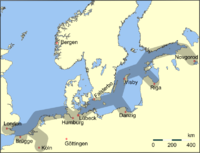
Saxon Quarter Baltic Quarter Westphalian
QuarterPrincipal Kontore Subsidiary Kontore Other cities Categories:- Municipalities of Hordaland
- Bergen
- Cities and towns in Norway
- Populated coastal places in Norway
- 1070 establishments
- Populated places established in the 11th century
- Port cities and towns in Norway
- Port cities and towns of the North Sea
- Viking Age populated places
- European Capitals of Culture
- Folk museums
Wikimedia Foundation. 2010.



